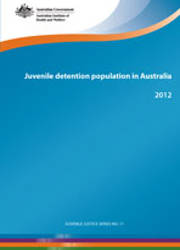Summary
Although most young people in Australia who have committed, or allegedly committed, a criminal offence are supervised in the community, some are in detention.
This report presents information on the juvenile detention population, focusing on trends over the 4-year period from the June quarter 2008 to the June quarter 2012.
Few young people are in detention in Australia
There were 1,024 young people in detention on an average night in the June quarter of 2012. Most (78%) were aged 10-17. This equates to a rate of 0.35 young people in detention per 1,000 aged 10-17, or around 1 in every 3,000 young people. Just over half (53%) of those in detention were Indigenous and most (91%) were young men.
Numbers and rates of detention are stable
Numbers and rates of young people in detention on an average night remained relatively stable over the 4-year period to the June quarter 2012. There was little overall change in either the number of young people (of all ages) in detention (down 1%) or the rate of detention among those aged 10-17 (from 0.37 to 0.35 per 1,000) over the period.
One in two young people in detention have not been sentenced
Just over half (52%) of those in detention on an average night in the June quarter 2012 were unsentenced that is, awaiting the outcome of their court matter or sentencing.
There was little change in the number and proportion of young people in detention who were unsentenced over the 4-year period. In the most recent year, there was an increase in the unsentenced population (up 9%) and a decrease in the sentenced population (down 9%).
Trends vary among the states and territories
There were differences in the trends in the detention population among the states and territories. Over the 4-year period, rates of young people in detention on an average night decreased in New South Wales, Tasmania and Victoria, remained relatively stable in Western Australia and increased in the other states and territories.
Indigenous over-representation has increased, particularly in unsentenced detention
On an average night in the June quarter 2012, Indigenous young people aged 10-17 were 31 times as likely as non-Indigenous young people to be in detention, up from 27 times in the June quarter 2008. The level of Indigenous over-representation (as shown by the rate ratio) increased in unsentenced detention over the 4-year period (from 24 to 31 times), but decreased slightly in sentenced detention (from 32 to 30 times).
Preliminary material: Acknowledgments; Abbreviations
1 Introduction
1.1 Young people in detention
1.2 Age
1.3 Legal status
1.4 Data on the detention population
2 Recent trends in detention
2.1 Key points
2.2 Number in detention
2.2 Key points
2.3 Number in detention
2.4 Rate of detention
2.5 Legal status
3 Recent trends in unsentenced detention
3.1 Key points
3.2 Number in unsentenced detention
3.3 Rate of unsentenced detention
4 Recent trends in sentenced detention
4.1 Key points
4.2 Number in sentenced detention
4.3 Rate of sentenced detention
5 State and territory trends
5.1 Key points
5.2 New South Wales
5.3 Victoria
5.4 Queensland
5.5 Western Australia
5.6 South Australia
5.7 Tasmania
5.8 Australian Capital Territory
5.9 Northern Territory
Appendixes
Appendix A Summary table
Appendix B Data and methods
End matter: Glossary; References; List of figures and table; Related publications



